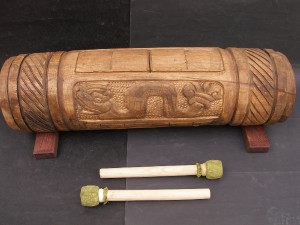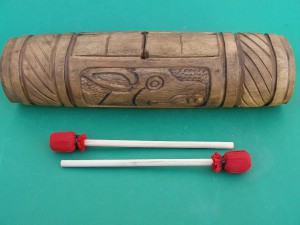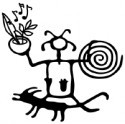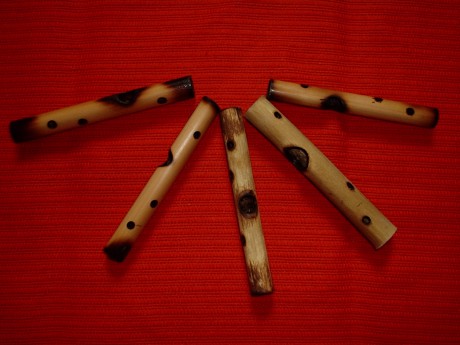Teponaztli drum


Teponaztli
From Wikipedia, the free encyclopedia Z Wikipedie, otevřené encyklopedie


A teponaztli is a type of slit drum used in central Mexico by the Aztecs and related cultures. Teponaztli je druh štěrbiny bubnu používaných v centrálním Mexiku Aztecs a příbuzných kultur.
Teponaztli are made of hollow hardwood logs, often fire-hardened. Teponaztli jsou vyrobeny z tvrdého dřeva dutých špalků, často oheň-odolné. Like most slit drums, teponaztli have three slits on their topside, cut into the shape of an "H". Jako většina slit bubny, teponaztli tři rozparky na jejich nahoře, řezané do tvaru "H". The resultant tongues are then struck with rubber balls on mallets, which were often made of deer antlers. [ 1 ] Since the tongues are of different lengths, or carved into different thicknesses, the teponaztli produces 2 different pitches, usually a third or fourth apart. [ 2 ] Výsledný jazyky jsou pak udeřil s gumovou koulí na paličky, které byly často vyrobeny z jelení parohy. [1] Vzhledem k tomu, jazyky jsou různé délky, nebo vyřezal do různých tloušťkách, teponaztli produkuje 2 různá hřiště, zpravidla třetí nebo čtvrtý od sebe . [2]
Teponaztli were usually decorated with relief carvings of various deities or with abstract designs, and were even carved into the shapes of creatures or humans. Teponaztli byly obvykle zdobeny reliéfy z různých božstev nebo s abstraktními vzory, a dokonce vytesané do tvarů živočichů nebo člověka. Some of these creatures are open-mouthed, providing increased volume through the hole at the end. Některé z těchto tvorů jsou s otevřenými ústy, poskytuje zvýšený objem otvorem na konci. On other drums, a hole was made on the drum's underside. Na jiných bubny, byla díra provedena na buben na spodní. Teponaztli from the Mixtec culture in what is today south-central Mexico are known for their various battle or mythological scenes carved in relief. Teponaztli z Mixtec kultury v čem je dnes jihu-centrální Mexiko je známé pro své různé bitvy nebo mytologické výjevy vyřezal v reliéfu.
These drums ranged in size from about 1 foot (30 cm) to 4 feet (1.2 metres) long. Tyto bicí se pohyboval ve velikosti od asi 1 noha (30 cm) až 4 stop (1,2 metru). The larger teponaztli would be rested upon a supporting frame. Větší teponaztli by spočívala na nosný rám. The smaller ones could either be rested on a frame or carried by straps about the shoulders. Menších by mohla být buď spočívala na rámu nebo přepravovaného popruhy kolem ramen.
Motolinia , a Franciscan friar and chronicler of post-conquest Aztec life, stated that the teponaztli, or as he called it the contrabajos (counterbass), was often played with the huehuetl skin drum to accompany various dances. [ 3 ] In addition to dances, teponaztlis were used to accompanied poetry readings: the sounds of the drum even at times appear within the poetry itself (" totocoto tototo cototo tiquititi titiqui tiquito "). [ 4 ] This solfege -style notation allows us to reconstruct the rhythms and sounds of the Aztecs. Motolinia , františkánský mnich a kronikář post-dobytí aztécké života, uvedl, že teponaztli, nebo jak on volal to contrabajos (counterbass), často hrál s huehuetl kůže bubnu doprovázet různé tance. [3] Kromě tance , teponaztlis byly použity k doprovázet čtení poezie: za zvuků bubnu iv době objeví v poezii samotného ("totocoto tototo cototo tiquititi titiqui tiquito"). [4] Tento solfege -styl notace nám umožňuje rekonstruovat rytmy a zvuky Aztecs.
The drums were also used in other celebrations (as shown in the Florentine Codex above) or in warfare as a means of communication. Bubny byly také použity v jiných oslav (jak je uvedeno v Florentine Codex výše) nebo ve válčení jako prostředek komunikace. According to some sources, on important state occasions the blood of sacrificial victims was at times poured into the drum. [ 5 ] Podle některých zdrojů, o významných státních příležitostech krev obětních obětí byl v době, nalije do bubnu. [5]
[ edit ] Notes [ editovat ] Poznámky
[ edit ] References [ editovat ] Reference
- Coe, Michael D. (2002); Mexico: From the Olmecs to the Aztecs , London: Thames and Hudson. Coe, Michael D. (2002), Mexiko: Od Olmecs k Aztecs, Londýn: Temže a Hudson.
- Collier, Simon; Skidmore, Thomas E.; Blakemore, Harold (1992) The Cambridge Encyclopedia of Latin America and the Caribbean , Cambridge World Encyclopedia, Cambridge University Press. Collier, Simon, Skidmore, Thomas E., Blakemore, Harold (1992) Cambridge Encyclopedia of Latinské Ameriky a Karibiku, Světová encyklopedie Cambridge, Cambridge University Press.
- Guggenheim Museum, The Aztec Empire: Catalogue of the Exhibition , Guggenheim Museum, New York. Guggenheim Museum, aztécké říše: Katalog výstavy, Guggenheim Museum, New York.
- Motolinia, Toribio de Benavente , Historia de los Indios de la Nueva España . Motolinia, Toribio de Benavente , Historia de los Indios de la Nueva España .
- " Teponaztli ", in Dictionary of Musical Instruments , University of Michigan School of Information, Cultural Heritage Initiative for Community Outreach, accessed April 2007. " Teponaztli "ve slovníku hudebních nástrojů, University of Michigan školy informací, kulturní dědictví Iniciativy Společenství Outreach, přístup dubna 2007.
[ edit ] External links [ editovat ] Externí odkazy
- Understanding the teponaztli rhythms, with audio files. Pochopení teponaztli rytmy, s audio soubory.
- Description and photo of an owl-shaped teponaztli at the British Museum. Popis a fotografii sovy-formoval teponaztli v Britském muzeu.
- Description and photo of a Mixtec teponaztli at the British Museum. Popis a fotografii Mixtec teponaztli v Britském muzeu.
- Teponaztli audio files. Teponaztli audio souborů.

